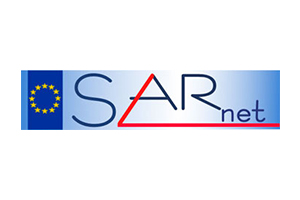
Most of the actors involved in severe accident research in Europe, plus Canada, Korea and the United States (41 partners), will network in SARNET2 (Severe Accident Research NETwork of Excellence – Phase 2) their capacities of research in order to resolve important pending issues on postulated severe accidents of existing and future Nuclear Power Plants (NPPs). The project has been defined in order to optimise the use of the available means and to constitute a sustainable consortium in which common research programmes and a common computer tool to predict NPP behaviour during a postulated severe accident (ASTEC integral code) are developed. With this aim, the SARNET2 partners contribute to a Joint Programme of Activities, which consists of: – Maintaining and improving an advanced communication tool (developed during SARNET Phase 1) for accessing all project information, fostering exchange of information, and managing documents; – Harmonizing and re-orienting the research programmes, and defining new ones; – Performing experimental programmes on high priority issues, defined during SARNET Phase 1; – Analyzing experimental results in order to elaborate a common understanding of relevant phenomena; – Developing the ASTEC code (including its applicability to all types of European NPPs), which capitalizes in terms of physical models the knowledge produced within SARNET2; – Developing Scientific Databases, in which all the results of research programmes are stored in a common format (DATANET); – Developing education courses on severe accidents for students and researchers, and training courses for specialists; – Promoting personnel mobility amongst various European organizations; – Organizing yearly a large international conference on Severe Accident research (ERMSAR). After the first phase (2004-2008), and the four-year proposed second phase, co-funded by the EC, the network will evolve toward self-sustainability: a legal entity will be created.
LEI activities in the Project
Specialits of Laboratory of Nuclear Inatalations in SARNET-2 project conducted research in three working groups:
- WP4 ASTEC – Adaptation and verification of ASTEC Integrated Program Package for Modeling of Severe Accidents in Nuclear Power Plants;
- WP5 COOL – Research of core melting and debris cooling;
WP7 CONT – Analysis of Processes in the Containments of Nuclear Power Plants.
Total cost: 39 588 707,20 EUR (LEI part: 24 439 EUR)
Coordinator: INSTITUT DE RADIOPROTECTION ET DE SURETE NUCLEAIRE, France
Participants:
- MAGYAR TUDOMANYOS AKADEMIA KFKI ATOMENERGIA KUTATOINTEZET, Hungary
- AREVA NP GMBH, Germany
- AREVA NP SAS, France
- BUDAPESTI MUSZAKI ES GAZDASAGTUDOMANYI EGYETEM, Hungary
- COMMISSARIAT A L ENERGIE ATOMIQUE ET AUX ENERGIES ALTERNATIVES, France
- RICERCA SUL SISTEMA ENERGETICO – RSE SPA, Italy
- CHALMERS TEKNISKA HOEGSKOLA AB, Sweden
- CENTRO DE INVESTIGACIONES ENERGETICAS, MEDIOAMBIENTALES Y TECNOLOGICAS-CIEMAT, Spain
- NATIONAL CENTER FOR SCIENTIFIC RESEARCH “DEMOKRITOS”, Greece
- ELECTRICITE DE FRANCE S.A., France
- ENERGY INSTITUTE JSC, Bulgaria
- AGENZIA NAZIONALE PER LE NUOVE TECNOLOGIE, L’ENERGIA E LO SVILUPPO ECONOMICO SOSTENIBILE, Italy
- FORSCHUNGSZENTRUM JULICH GMBH, Germany
- KARLSRUHER INSTITUT FUER TECHNOLOGIE, Germany
- GESELLSCHAFT FUER ANLAGEN- UND REAKTORSICHERHEIT (GRS) MBH, Germany
- REGIA AUTONOMA PENTRU ACTIVITATI NUCLEARE DROBETA TR. SEVERIN RA SUCURSALA CERCETARI NUCLEARE PITESTI, Romania
- INSTITUTE OF NUCLEAR RESEARCH AND NUCLEAR ENERGY – BULGARIAN ACADEMY OF SCIENCES, Bulgaria
- INZINIERSKA VYPOCTOVA SPOLOCNOST TRNAVA S.R.O., Slovakia
- INSTITUT JOZEF STEFAN, Slovenia
- KUNGLIGA TEKNISKA HOEGSKOLAN, Sweden
- LIETUVOS ENERGETIKOS INSTITUTAS, Lithuania
- NATIONAL NUCLEAR LABORATORY LIMITED, United Kingdom
- NUCLEAR RESEARCH AND CONSULTANCY GROUP, Netherlands
- PAUL SCHERRER INSTITUT, Switzerland
- RUHR-UNIVERSITAET BOCHUM, Germany
- TRACTEBEL ENGINEERING S.A., Belgium
- THERMODATA, France
- TECHNICAL UNIVERSITY OF SOFIA, Bulgaria
- URAD JADROVEHO DOZORU SLOVENSKEJ REPUBLIKY, Slovakia
- UJV REZ, a.s., Czech Republic
- UNIVERSITY OF NEWCASTLE UPON TYNE, United Kingdom
- UNIVERSITA DI PISA, Italy
- UNIVERSITAET STUTTGART, Germany
- NUBIKI NUCLEAR SAFETY RESEARCH INSTITUTE LTD., Hungary
- TEKNOLOGIAN TUTKIMUSKESKUS VTT, Finland
- VUJE AS, Slovakia
- JRC -JOINT RESEARCH CENTRE- EUROPEAN COMMISSION, Belgium
- ATOMIC ENERGY OF CANADA LIMITED, Canada
- KOREA ATOMIC ENERGY RESEARCH INSTITUTE, South Korea
- U.S. Nuclear Regulatory Commission, United States
- KOREA INSTITUTE OF NUCLEAR SAFETY, South Korea
- SUEZ-TRACTEBEL SA, Belgium
- VEIKI INSTITUTE FOR ELECTRIC POWER RESEARCH, Hungary
- DEPARTMENT OF ATOMIC ENERGY, India
Project Team
| Name, surname | Office | phone. | |
|---|---|---|---|
|
LEI Representative |
|||
| Algirdas Kaliatka | 223-AK | +37037401903 | Algirdas.Kaliatka@lei.lt |
|
Project Team |
|||
| Eugenijus Ušpuras | |||
| Egidijus Urbonavičius | 105-AK | +37037401914 | Egidijus.Urbonavicius@lei.lt |
| Virginijus Vileiniškis | 251-AK | +37037401928 | Virginijus.Vileiniskis@lei.lt |
| Mindaugas Vaišnoras | 414-AK | +37037401954 | Mindaugas.Vaisnoras@lei.lt |
| Robertas Alzbutas | 317-AK | +37037401945 | Robertas.Alzbutas@lei.lt |
| Viktoras Ognerubovas | |||
| Tomas Kačegavičius | 250-AK | +37037401836 | Tomas.Kacegavicius@lei.lt |
| Tadas Kaliatka | 415-AK | +37037401911 | Tadas.Kaliatka@lei.lt |
| Mantas Povilaitis | 254-AK | +37037401920 | Mantas.Povilaitis@lei.lt |





